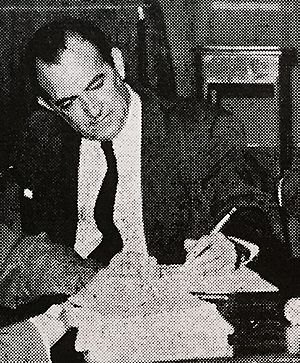Miguel Otero Silva facts for kids
Quick facts for kids
Miguel Otero Silva
|
|
|---|---|
 |
|
| Born | October 26, 1908 Barcelona, Anzoátegui |
| Died | August 28, 1985 (aged 76) Caracas, Venezuela |
| Occupation | journalist, novelist, poet, politician |
| Nationality | Venezuelan |
| Notable works | Casas Muertas (1955) |
| Signature | |
 |
|
Miguel Otero Silva (born October 26, 1908 – died August 28, 1985) was an important writer, journalist, and politician from Venezuela. His books and newspaper articles often talked about the social and political history of Venezuela. Miguel Otero Silva had a tough life. He was often forced to leave his home country and live somewhere else. This is called being in exile. Later, when Venezuela became a democratic country in 1958, he was chosen to be a member of the Venezuelan Senate.
Contents
Early Life and Becoming a Writer
Miguel Otero Silva was born in Barcelona, a city in Anzoátegui, Venezuela. When he was very young, he moved to Caracas to go to high school. After that, he studied civil engineering at the Universidad Central de Venezuela.
During his time at university, he started writing for magazines and newspapers. He also began his career in journalism.
Fighting for Change in Venezuela
In 1928, when he was a student, Miguel Otero Silva joined many protests against the ruler of Venezuela, a dictator named Juan Vicente Gómez. These protests were part of a big movement called the Generation of 1928.
He also got involved in a secret plan to remove the government. This plan made him have to leave Venezuela and go to Curaçao. While in Curaçao, he and other Venezuelan friends tried to take over Fort Amsterdam in Willemstad on June 29, 1929. They hoped this would help overthrow President Gómez.
The plan did not work. Otero Silva had to go into exile again, this time in Colombia. During this time, he worked on his first novel, Fiebre (which means Fever). It was published later in 1939. By 1930, he had also joined a group that believed in Marxist ideas.
Returning Home and New Beginnings
Miguel Otero Silva was able to come back to Venezuela after the dictator Juan Vicente Gómez died in 1935. The new leader allowed more freedom of speech. Otero Silva used this freedom to publish funny political poems in newspapers.
However, he was soon seen as a communist, and the government made him leave the country again in 1937. For three years, he traveled a lot through Mexico, the United States, and Colombia. He even joined the International Brigades to support the good side during the Spanish Civil War.
Starting Newspapers and Writing Books
When he returned to Venezuela, he helped start a funny weekly newspaper called El Morrocoy Azul (The Blue Tortoise). He also started a newspaper called ¡Aquí Está! (Here It Is!), which shared left-wing ideas.
In 1943, Miguel Otero Silva's father started a daily newspaper called El Nacional. His father made him the head of the press. At the same time, Otero Silva decided to study journalism at the Universidad Central de Venezuela. In 1946, he married María Teresa Castillo, who was also a journalist. He finished university in 1949.
Two years later, Otero Silva left the Communist Party of Venezuela. He said he wanted to focus on his writing instead of politics. He spent a year researching the history of a village called Ortiz. This village inspired his next novel, Casas Muertas (Dead Houses), which came out in 1955. This book won important awards, including the Premio Nacional de Literatura.
His newspaper, El Nacional, was stopped twice when Marcos Pérez Jiménez was the military ruler. Near the end of this ruler's time, Otero Silva was arrested. He had helped publish a document called the Manifiesto de los Intelectuales (Intellectuals Manifesto), which criticized the government.
Life After the Dictatorship
After Marcos Pérez Jiménez was overthrown in 1958, Miguel Otero Silva received the National Prize for Journalism. He was also elected to the Venezuelan Senate, representing the state of Aragua.
However, his newspaper El Nacional was again criticized for having communist ideas by the new government. Because of this, Otero Silva decided to stop working as an active journalist.
During this time, he wrote more books, including Oficina N° 1 (1961) and La Muerte de Honorio (1963). He also wrote Las Celestiales (1965), a book of funny poems about politics and religion. He used a made-up name, "Iñaki de Errandonea", for this book.
In 1967, Otero Silva became a full member of the Academia Venezolana de la Lengua, which is like a special group for people who are experts in the Spanish language. As a senator, he helped create the Instituto Nacional de Cultura y Bellas Artes (INCIBA) in the 1970s. He also helped start the Galería de Arte Nacional, a national art gallery. In 1979, Otero Silva received the Lenin Peace Prize.
Miguel Otero Silva died in Caracas on August 28, 1985, shortly after publishing his last book, La Piedra que era Cristo.
Awards and Recognitions
- Premio Nacional de Literatura (1955, for his novel Casas Muertas)
- National Prize of Journalism
- Member of the Academia Venezolana de la Lengua (1967)
- Lenin Peace Prize (1979)
Fun Facts
- In Miguel Otero Silva's first five novels, the number of words in the title matches the order in which they were published.
- Fiebre, his first novel, has one word.
- Casas Muertas, his second, has two words.
- This pattern continues up to Cuando quiero llorar, no lloro, his fifth novel, which has five words. After this, the pattern stops. It seems like he planned this!
- In 2006, a book about Miguel Otero Silva's life was written by Argenis Martínez. It was part of a series called Biblioteca Biográfica Venezolana.
See also
 In Spanish: Miguel Otero Silva para niños
In Spanish: Miguel Otero Silva para niños

